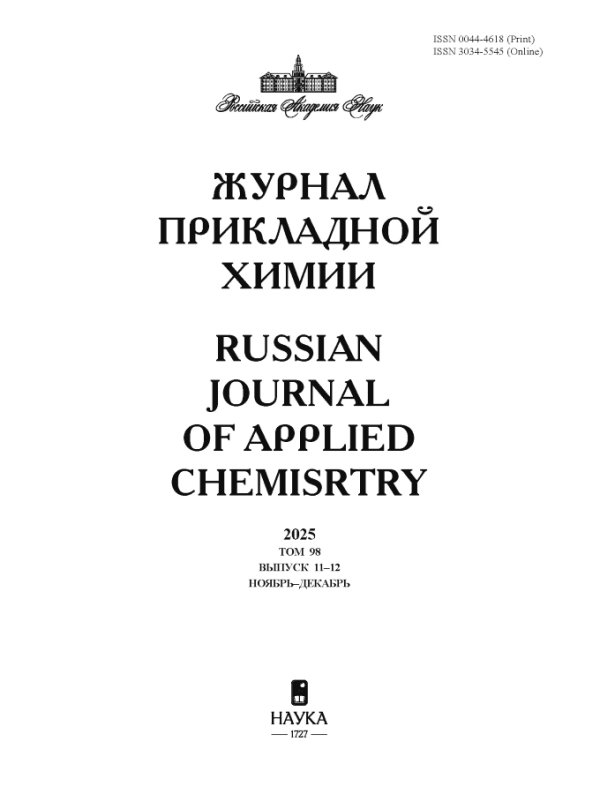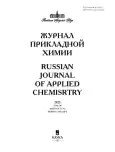Russian Journal of Applied Chemistry
ISSN (print): 0044-4618
Media registration certificate: No. 0110250 dated 02/09/1993
Founder: Russian Academy of Sciences
Editor-in-Chief: Maksimov Anton Lvovich
Number of issues per year: 12
Indexation: RISC, list of Higher Attestation Commissions, CrossRef, White List (level 2)
The Russian Journal of Applied Chemistry (Zhurnal Prikladnoi Khimii) covers all application problems of modern chemistry, including the structure of inorganic and organic compounds, kinetics and mechanisms of chemical reactions, problems of chemical processes and apparatus, borderline problems of chemistry and applied research. The journal was founded in 1928.
Current Issue
Vol 98, No 11-12 (2025)
Articles
MEMBRANNOE GAZORAZDELENIE DLYa IZVLEChENIYa KISLYKh KOMPONENTOV IZ GAZOVYKh SRED: SOVREMENNOE SOSTOYaNIE I PERSPEKTIVY (obzor)
Abstract
В обзоре рассмотрена проблема очистки газовых потоков от кислых (CO2, H2S, SOx, NOx) газов, обоснована целесообразность применения технологии мембранного газоразделения. Представлен анализ рынка газоразделительных мембран и дан критический анализ существующих разработок в области мембранного материаловедения и коммерческих мембранных решений для выделения кислых газов. Обсуждены потенциальные области применения перспективных мембранных материалов. Описаны направления развития мембранного удаления кислых компонентов из газовых сред, обозначены нерешенные проблемы и возможности для будущих исследований в этой области.
 544-572
544-572


PERSPEKTIVY RAZVITIYa ENERGETIKI. SRAVNITEL'NYY ANALIZ EFFEKTIVNOSTI TERMODINAMIChESKIKh I ELEKTROKhIMIChESKIKh ENERGOUSTANOVOK V EPOKhU ENERGETIChESKOGO PEREKhODA (obzor)
Abstract
В обзоре рассматриваются методологические основы определения коэффициента полезного действия (КПД) энергетических установок и предлагается классификация КПД с учетом характера потерь, преобразуемой энергии, теоретического предела эффективности и области применения. Особое внимание уделено выбору энергетической базы для расчета КПД — от традиционно используемой низшей теплоты сгорания до более фундаментальных характеристик, таких как химическая энергия и эксepгия. На основе методики В. С. Степанова выполнены расчеты теплотворной способности, химической энергии и эксepгии для метана и водорода, а также произведен сопоставительный анализ электрического КПД газотурбинной установки и топливной ячейки. Установлено, что применение эксергетического подхода позволяет более объективно оценивать эффективность энергетических технологий различной природы. Показана необходимость внимательного подхода к выбору расчетной энергетической базы для корректного анализа, инженерных решений и сравнения систем. Отдельное внимание уделено анализу потенциала повышения КПД топливных ячеек и их преимуществ перед традиционными термодинамическими установками. Обозначены тренды развития новых критериев оценки эффективности энергетических процессов, включая специфические свойства таких элементов, как горелочные устройства и камеры сгорания.
 573-590
573-590


Compositional Materials
RAZRABOTKA SOSTAVA UGLEROD-POLIMERNYKh POKRYTIY NA ALYuMINIEVOY FOL'GE
Abstract
Изучено влияние состава углерод-полимерных защитных покрытий на адгезию к алюминиевой фольге, эластичность и набухаемость в электролитных системах линий-ионных и линий-серных аккумуляторов. В качестве полимерных связующих были изучены бутилстиральный каучук, карбоксиметилцеллюлоза, акриловый латекс и их смесь. В качестве токопроводящей добавки использовали техническую сажгу П803 (ГОСТ 7885–86), а дисперсионной среды — дистиллированную воду. Установлено, что наилучшими свойствами (электропроводностью, высокой адгезией к алюминиевой фольге, эластичностью и низкой пористостью) обладают углерод-полимерные покрытия, включающие 80% сажи П803, 17.5% акрилового латекса и 2.5% карбоксиметилцеллюлозы.
 591-599
591-599


Водородные технологии
FORMIROVANIE I ISSLEDOVANIE VODOROD-AKKUMULIRUYuShchIKh KOMPOZITOV TiFe S ZhELEZO-GRAFENOVYM KATALIZATOROM DLYa KhRANENIYa VODORODA
Abstract
Исследовано формирование композитов TiFe с железо-графеновым катализатором механохимической обработкой в атмосфере водорода и определены их водородсорбционные характеристики. Показано, что добавка железо-графенового катализатора к сплавам Ti с Fe увеличивает скорость процесса гидрирования и обеспечивает высокую обратимую водородосикость композита. На основе водород-аккумулирующего композита изготовлен опытный образец аккумулятора водорода и установлены его эксплуатационные характеристики.
 600-608
600-608


Неорганический синтез и технология неорганических производств
SRAVNITEL'NOE ISSLEDOVANIE SVOYSTV KSEROGELEY, NANOPOROShKOV I KERAMIChESKIKh MATERIALOV V SISTEME CeO2–Dy2O3, POLUChENNYKh METODAMI SOVMESTNOGO OSAZhDENIYa V LABORATORNOY USTANOVKE I SOOSAZhDENIYa V MIKROREAKTORE SO VSTREChNYMI ZAKRUChENNYMI POTOKAMI
Abstract
Двумя методами жидкофазного синтеза — методом совместного осаждения гидроксидов в лабораторной установке с магнитной мешалкой и методом быстрого совместного осаждения гидроксидов в микрореакторе со встречными закрученными потоками синтезированы высокодисперсные метопористые порошки состава (CeO2)1-x(Dy2O3)x (x = 0.05, 0.10, 0.15. 0.20), обладающие удельным объемом пор 0.022–0.084 см3·г−1 и удельной площадью поверхности 23.71–66.32 м2·г−1. На их основе получены керамические напоматериалы заданного состава, представляющие собой кубические твердые растворы типа флюорита с ОКР ~ 44–76 нм, с открытой пористостью в интервале 3–14%, высокими значениями кажущейся плотности 5.87–7.24 г·см−3. Выявлено существенное влияние условий проведения синтеза на физико-химические свойства керамических электролитных материалов. Показано, что спекающая добавка ZnO для керамики, полученной двумя разными методами синтеза, влияет на открытую пористость и плотность по-разному: в случае использования метода синтеза в микрореакторе со встречными закрученными потоками (расход 1.5 л·мин−1) открытая пористость уменьшилась в 2–5 раз, плотность увеличилась незначительно. Однако для образцов, синтезированных методом соосаждения гидроксидов в лабораторной установке, пористость снизилась в 2 раза, что доказывает избирательное влияние спекающих добавок. По своим физико-химическим свойствам (плотность, пористость, коэффициент термического расширения) полученные керамические материалы перспективны в качестве твердооксидных электролитов среднетемпературных топливных элементов.
 609-620
609-620


Высокомолекулярные соединения и материалы на их основе
OTsENKA KOAGULIRUYuShchEGO DEYSTVIYa SUL'FAMINOVOY KISLOTY V PROTsESSAKh VYDELENIYa BUTADIEN-STIROL'NOGO KAUChUKA IZ LATEKSA
Abstract
Проведена оценка коагулирующей способности сульфаминовой кислоты в процессе выделения из латеков бутадиен-стирольного каучука. Исследовано влияние на полноту выделения каучука таких факторов, как температура, расход коагулирующего и подкисляющего агентов. Оптимальные условия выделения каучука из латекса с выходом полимера 98% предусматривают расход коагулянта 40 кг∙т–1 при температуре 1–2°C. Отмечена особенность поведения сульфаминовой кислоты, заключающаяся в том, что при 60°C полнота выделения каучука из латекса не достигается без дозревания системы после введения в нее подкисляющего агента. Это связано с гидролизом термически неустойчивой сульфаминовой кислоты. Вулканизаты, полученные на основе выделенного каучука, по своим основным показателям соответствуют требованиям ГОСТ 15627–2019.
 621-626
621-626


Катализ
GIDRIROVANIE SO2 S ISPOL'ZOVANIEM Cu/Zn-KATALIZATOROV NA OSNOVE PORISTYKh AROMATIChESKIKh KARKASOV
Abstract
Углекислый газ представляет собой перспективный реагент для синтеза широкого круга ценных химических продуктов, в частности метанола. В настоящей работе впервые на основе как немодифицированных, так и модифицированных аминогруппами пористых ароматических каркасов синтезированы Cu/Zn-катализаторы для гидрирования CO2 в метанол. Рассмотрена взаимосвязь текстурных характеристик носителя и формирующихся в его структуре наночастиц активной фазы. Активность синтезированных в работе катализаторов исследована при 250°C и 40 атм (CO2/H2 = 1:3). Определен оптимальный состав катализатора, изучено влияние природы растворителя на его активность.
 627-637
627-637


PRIMENENIE PEREDOVYKh OKISLITEL'NYKh PROTsESSOV DLYa OChISTKI STOChNYKh VOD OT ORGANIChESKIKh ZAGRYaZNITELEY
Abstract
Исследована возможность очистки воды от фенола и ацетона с применением железосодержащих металлокерамических композитов на основе нитрида кремния, модифицированных полупроводниковыми соединениями, в условиях облучения УФ/видимым светом и озонирования. Композиты получены при азотировании ферросилиция в отсутствие и с добавкой природного минерала шунгита (для введения карбида кремния) в режиме горения. Для введения в керамическую матрицу композитов полупроводниковых фаз оксида железа(III) и нитрида углерода использовали мочевину. Установлен фазовый состав, изучена морфология и оптические свойства композитов. Проведена оценка адсорбционной и фотокаталитической активности композитов в отсутствие и с добавкой пероксида водорода при облучении УФ, видимым светом (процесс Фентона) и озонировании. Установлена высокая степень деградации фенола (~100%) с применением модифицированных композитов с добавкой пероксида водорода при облучении видимым светом. Показана устойчивость фотокатализаторов в восьми повторных циклах. Наиболее эффективным для окислительной деструкции ацетона (100%) в воде является озонирование, в том числе при облучении видимым светом. Исследованы продукты деградации ацетона и фенола методом ГХ и ГХ-МС.
 638-648
638-648


GIDRODEKhLORIROVANIE 1,4-DIKhLORBENZOLA V SISTEMAKh, SODERZhAShchIKh BENZOTIOFEN, NAFTALIN I 1-KhLORNAFTALIN, V PRISUTSTVII SUL'FIDNYKh NENANESENNYKh KATALIZATOROV, SINTEZIRUEMYKh IN SITU
Abstract
С целью изучения каталитической активности в конкурирующих процессах гидрогенолиза бикомпонентных систем (1,4-дихлорбензол/бензотиофен, 1,4-дихлорбензол/нафталин, 1,4-дихлорбензол/1-хлорнафталин) синтезированы моно- и биметаллические системы на основе ненанесенных сульфидов переходных металлов (Ni, W, Co, Mo, Fe). Наибольшие степени дехлорирования и обессеривания в параллельном процессе гидродехлорирования 1,4-дихлорбензола и гидрообессеривания бензотиофена достигаются в присутствии биметаллических NiWS, NiMoS и CoWS, в параллельном процессе гидродехлорирования 1,4-дихлорбензола и гидрирования нафталина — в присутствии биметаллических систем NiWS, NiMoS и FeMoS, в параллельном процессе гидродехлорирования и гидрирования 1,4-дихлорбензола и 1-хлориафталина — в присутствии биметаллических систем NiWS, CoMoS и NiMoS, что говорит о высокой активности именно NiMoS и NiWS среди всех исследуемых систем. Исследование морфологии и фазового состава NiWS, как наиболее активного катализатора, полученного in situ из маслорастворимых прекурсоров в реакционной среде, посредством рентгеновской фотоэлектронной спектроскопии и просвечивающей электронной микроскопии указывать на наличие на поверхности катализаторов фазы дисульфида вольфрама, сульфида никеля и смешанной фазы NiWS. Показано увеличение скорости реакции гидрообессеривания в присутствии NiWS и хлорсодержащего соединения. Взаимное ингибирование процессов дехлорирования и гидрирования наблюдается в двухкомпонентной системе, содержащей 1,4-дихлорбензол и нафталин и 1,4-дихлорбензол и 1-хлориафталин. Установлено, что в жидком продукте каталитической переработки смеси поливинилхлорида и полиспирола в присутствии in situ синтезированного катализатора NiWS содержится до 33% ароматических (в том числе хлорароматических ~10%) компонентов, в системе также установлено присутствие до 6% хлоралканов.
 649-664
649-664












